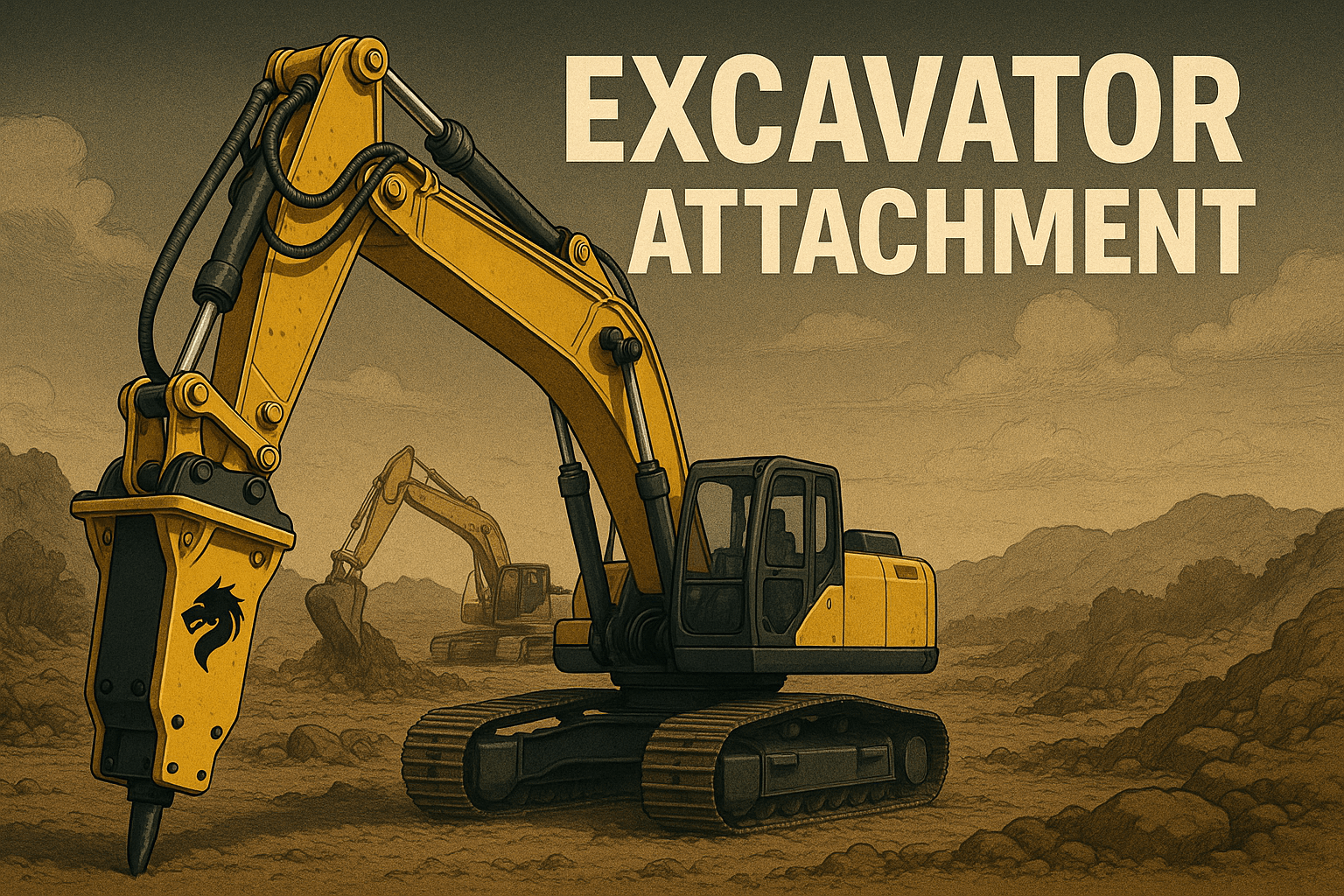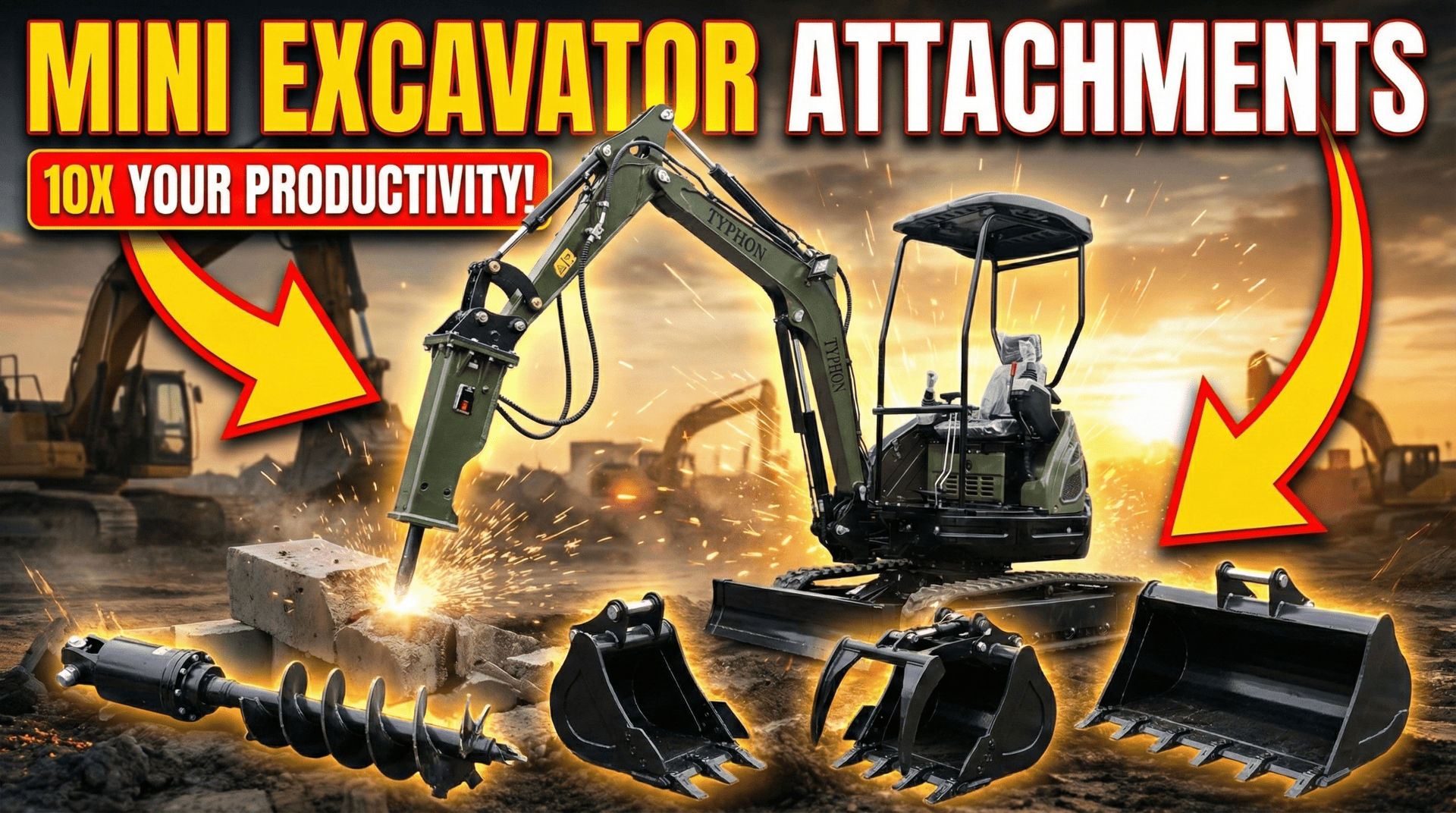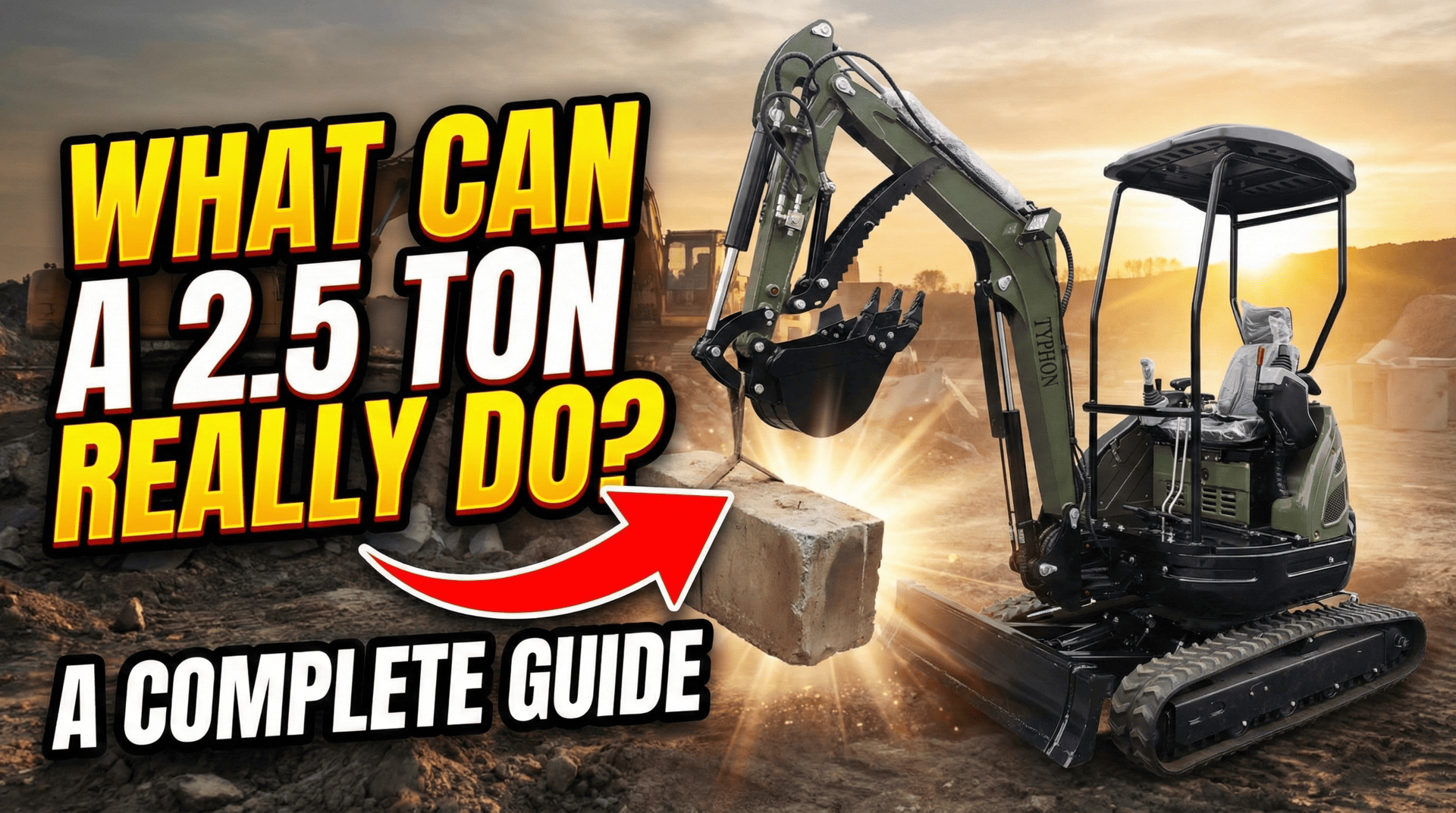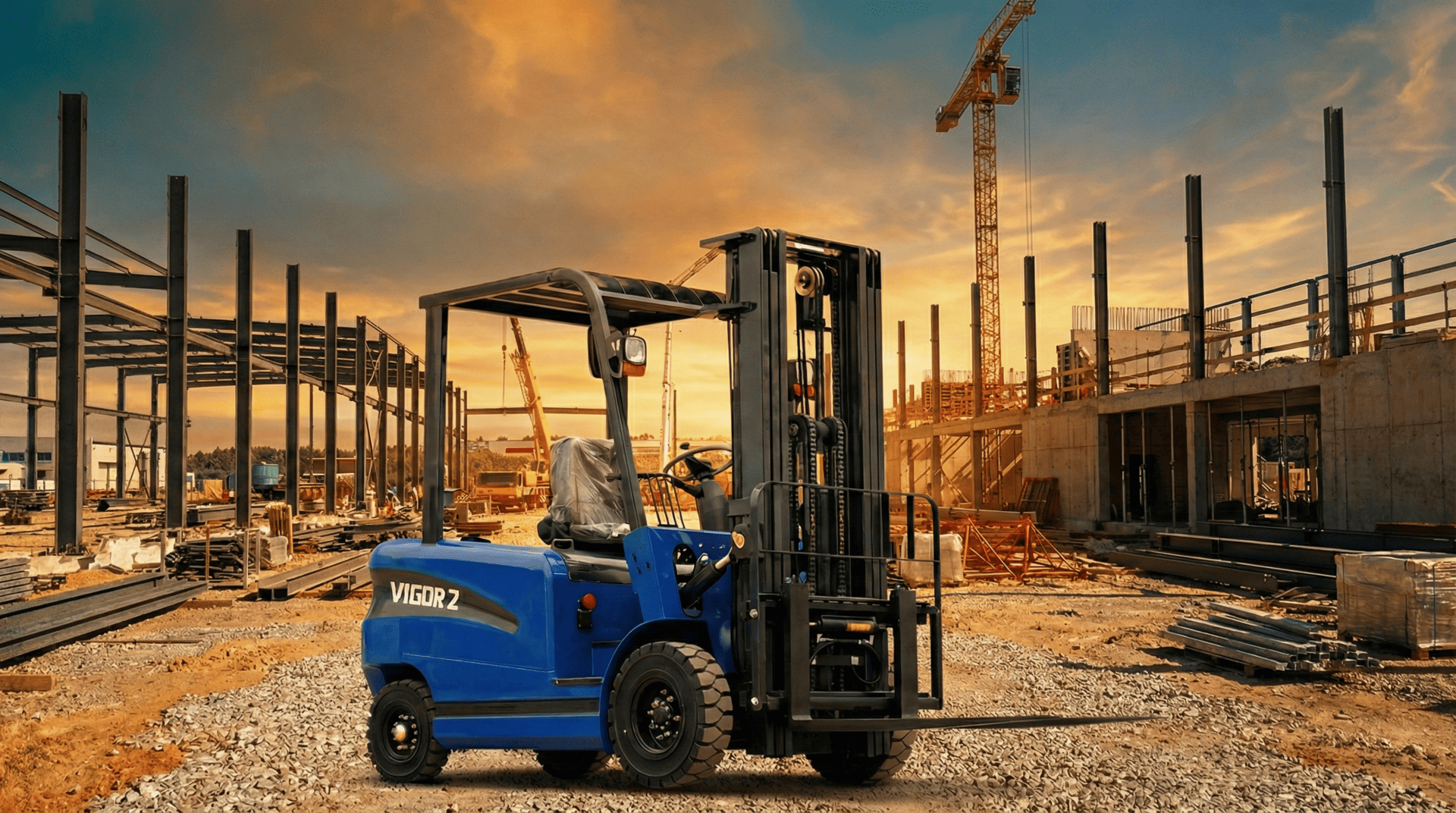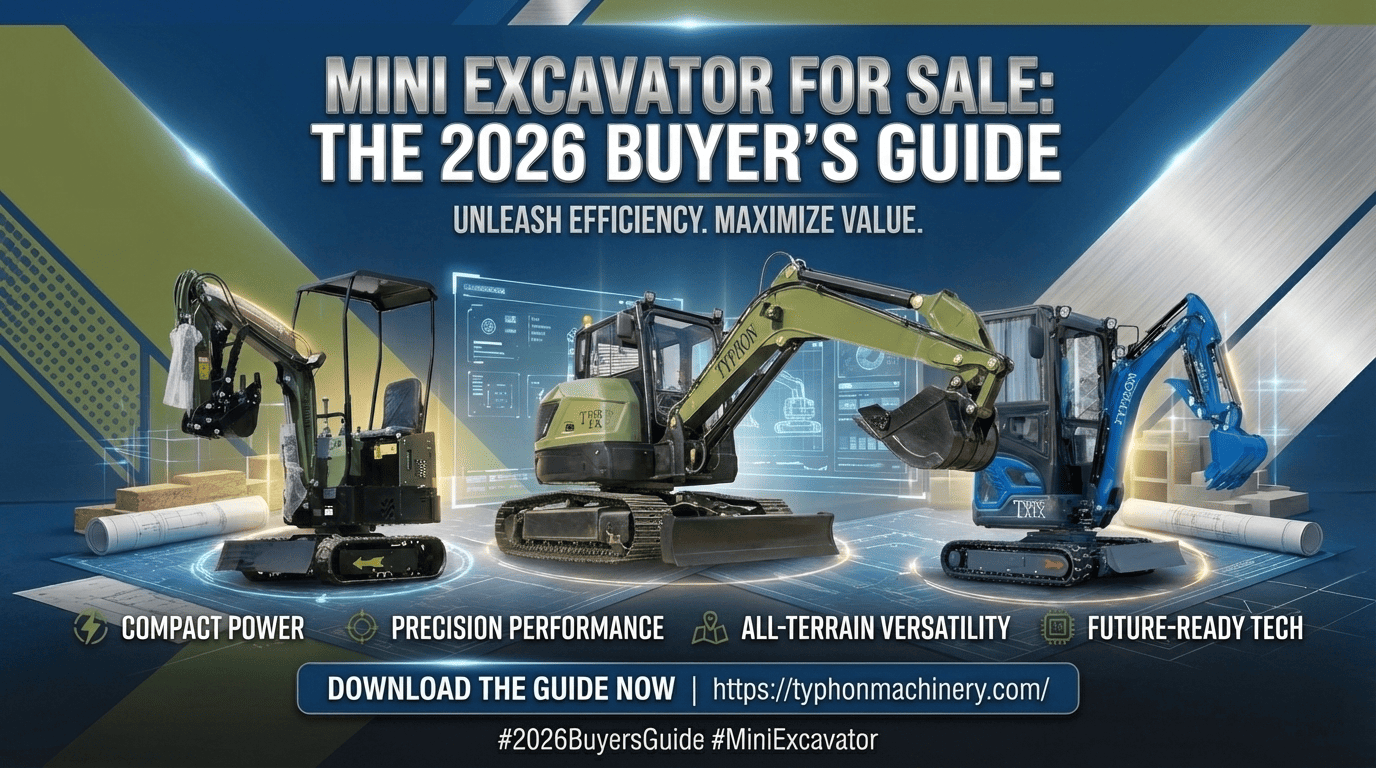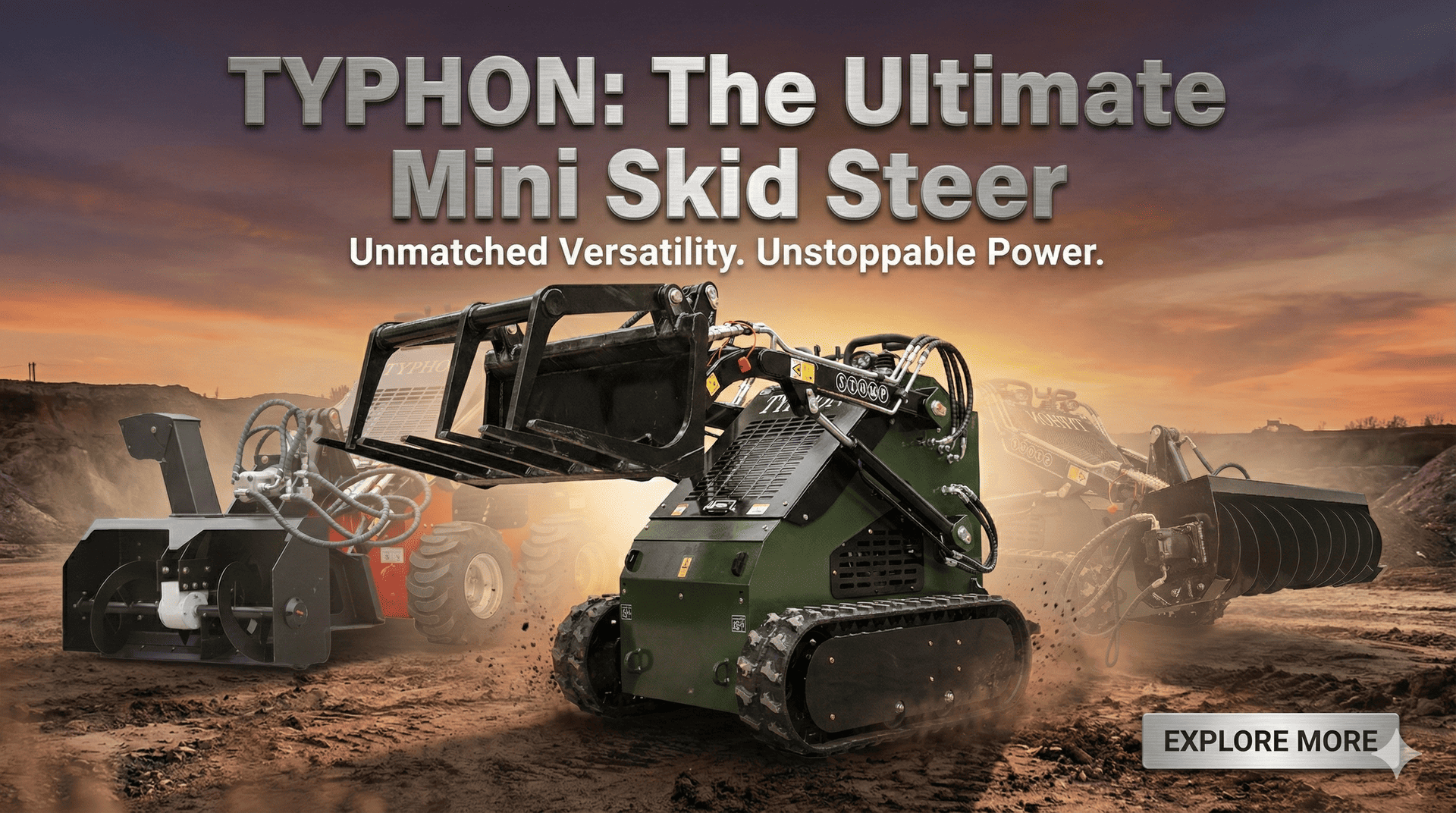Introduction to Excavator Attachments
What Are Excavator Attachments?
Excavator attachments are instruments specially created to be connected to a mini-excavator’s stick to carry through operations of simple excavation; for example, beyond just digging. A standard excavator that is attached with these tools becomes a multifunctional machine that can now do other tough work, such as in the construction, demolition, and landscaping sectors. The use of attachments allows an excavator to be more productive than ever, and the change can be from simple digging buckets to sophisticated hydraulic thumbs or compactors.
Attachments should not be thought of simply as extras that can be purchased and added later; rather, they should be seen as upgrades that are a necessary part of increasing the speed of an excavator during work.
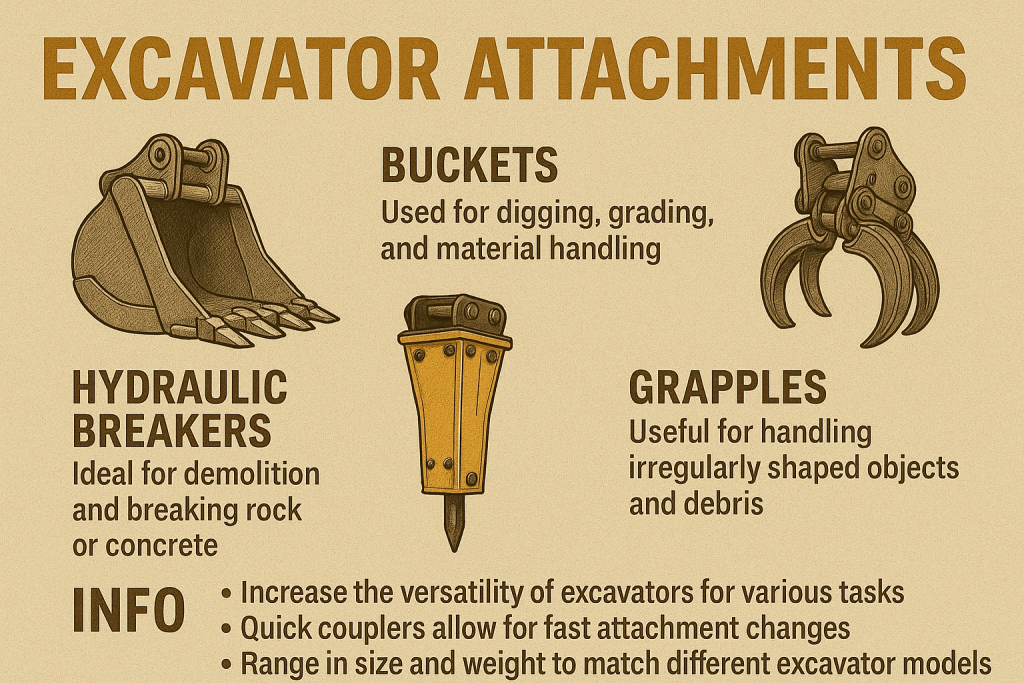
For every operation, there is a suitable attachment available — from breaking up concrete slabs to pulling logs. One can also change them for different jobs when they are used instead of another one. This increases the flexibility of an excavator system and thus magnifies the efficiency. In brief, they are what make excavators smarter, more helpful, and worth more to everyone on a construction site.
Why Are Attachments Important in Modern Construction?
In the current fast-paced and competitive construction sector, effectiveness with respect to time and money is very essential. The use of excavator attachments is very significant in the field of construction because it has the ability to make one machine become multifunctional.
For example, if a contract worker is required to perform multiple jobs such as excavation, compaction, or waste lifting, they will only need an excavator with many attachments, and they don’t have to rent or buy other machines.
Besides, the shift to sustainable construction seeks a reduction in the carbon footprint of machinery, better fuel usage, and more efficient machine output; in this case, an attachment can step in as a best match. The job is executed much faster when the worker has the right tools, which, in turn, leads to reduced time for each project, less labor, and a great fall in operating costs.
Not only do attachments bring many advantages for comfort, but they also ensure cost savings and the competitive advantage of the firms. Attachments have such a feature as a certain level of empowerment, and therefore, they are the ones who allow small companies to be competitive with big ones through efficiency and fast responses to various project needs.
Major Classes of Excavator Attachments
Buckets are so essential for excavation that no job can be done without them, and they are often given as part of the package when one buys an excavator. However, different bucket types differ in size and the kind of job they can handle, which means that not all buckets are typical of all jobs.
Trenching buckets are crafted more specifically; they are of smaller width and are ideal for digging narrow trenches in order to lay pipelines or cables. Ditching buckets, on the other hand, are suitable for wider purposes like grading, sloping, and cleaning ditches. Heavy-rock buckets reject wear and tear by being rock hard and thus can be used when one needs to move crushed rock.
A great feature of buckets is that they are versatile. The operators can easily switch from one type to another, making one excavator do everything from precise grading work to the most heavy-duty digging stuff.
The good quality of the buckets is certified through the presence of the reinforced edges of hardened steel and the right curvature that is aimed at achieving the maximum capacity while minimizing the wear and tear process. That said, it can easily be said that the bucket serves as the backbone of the construction site despite it being the most basic tool.
Hydraulic Hammers—Used for Demolition Tasks
When dealing with concrete, asphalt, or large rocks, hydraulic hammers (breakers) are the best attachment to use. They constitute a great addition to construction machines and use hydraulic fluid under pressure to move a piston, which in turn applies the force required to break the material. Such a purpose is essential in the case of the destruction of the building, starting the road, and extraction of the mineral, where the work is hard and very big.
Hammers used for the hydraulic mechanism of breaking apart the size of the output of the energy in the installation make it possible to use such an attachment as one for a compact excavator for work at home and as an additional one for a large machine that operates to deal with commercial or industrial demolition.
However, the correct choice of a hydraulic breaker should always be based on the excavator’s size and the compatibility of hydraulics to ensure the best performance. Normally, such tools are precise enough so that demolishing can be done proximity.
Excavator Attachments Classification
Auger—Digging Holes
Grapples are a very useful thing to have in projects that include irregularly shaped or non-typical materials such as very large lumber such as logs, scrap from construction, or metal waste. By using certain types of grappling, unlike the bucket, which scoops, carries, drops, ropes, and scorns, grapples perform the function of hydraulically operated clawed arms that either grab or release such things.
They are mainly used in demolition, material handling, warehouses, and waste sorting in order to make fragmentation easier in the first three, and in the case of the fourth, the sorting of reusable materials and the disposal of the rest take place in a more human-friendly and efficient way.
What largely determines the superiority of grapples is their great handleability. Workers can pick up even the most awkward and heavy objects without the danger of damaging them or dropping them. Therefore, the process of pulling up and removing the materials is done in a sense of great speed and also of minimal risky activities.
Demolition grapples render their strongest feature, good wearability, in the most severe conditions. They, therefore, lead in the timber industry.
The quality of the grapple does not only increase the efficiency and safety of the whole worksite but also of overall jobsite safety. As a result, the operations are speeded up, much manual handling is avoided, and fewer injuries are sustained. Grapples are an absolute must for anyone who has to handle uneven or irregular loads of material.
Augers—Precisely Shaped Holes
Augers are tools that help with the precise digging of holes, which are of great importance in activities such as fencing, landscaping, and foundation work. They work by rotating the screw-shaped tool to penetrate the earth, thus forming smooth holes with minimal earth disturbances. The results are holes that are not only fast but also clean, deep, and narrow when compared to traditional digging versions. The result is less time consumed compared to labor used.
Excavator hydraulic systems Both propel and auger bits are categorized in sizes. Once secured to an auger unit, the process of utility poles, tree planting, or placing of structural footings will be conducted with agility and accuracy. Bits can be used separately for hard and soft ground, rock drilling, or clay removal.
Augers have largely been designed as multi-functional tools. They have gone even to provide for deep holes by the use of extensions. There are even earth bits with rocky tips for the breaking of hard soil. The key point in this scenario is that by getting the right auger, the contractor owns the roles of the external services, thus maximizing profitability and job scope.
Thumbs—Increased Force Grip
Excavator thumbs are mechanical or hydraulic, and they are the ‘extra pair’ of the machine’s primary buckets or grapples to grip and maneuver materials. Basically, they are small auxiliary parts that are used to hold, carry, or bring into a specific location the elements that the bucket alone is unable to do it. They greatly facilitate the handling of trees, pipes, boulders, or debris in the demolition process.
The hydraulic thumb is a better option in terms of controlling the system because it has the auxiliary system of the digger working for it. This enables the operator to correct pressure and motion while in motion. The mechanical thumb, however, is static and not as diverse, but it is more economical and suits occasional or light tasks to be performed.
Without any doubt, the multifunction lever attachment to your excavator changes the handling of your excavator in the best possible way. Next to no material falls, the loading and unloading speeds are significantly faster, and everything is thus more secure due to the fact that only a minimal number of supervisors are working on the ground floor.
For those of you who are characterized as people of the job, that you may have to lift and carry heavy and thick items and also unload the whole machine from the craft, or even more, a thumb in the digging machine isn’t just something that you can afford, but it’s a condition.
Compactors—The Soil and Surface Compressors
The compactor attachment transforms the backhoe loader into a very effective machine for carrying out soil and surface work. Your jobs could be working on the foundations of the road, the trenches, and the filled backfields. Compact the soil, check for stability, level the ground, and make sure it is ready for construction with compactors.
What’s more, such attachments give life to the vibration and pressurized soil compacting, helping the machines achieve their main functions, thus saving more space inside where the air is replaced by pressure.
Using the compactor with the help of the excavator drone is really a good thing because you get work done faster, better, and with a reward for a job well done. Plate and roller compactors, the two major classes of compactors, are each useful in different tasks; hence, plate compactors are more advantageous where there are smaller areas and limited spaces, such as in the case of trenches, while rollers are perfect for wider spaces, and they are used to work on heavy-duty surfaces as well.
It is worth mentioning that solidification is at the border where this equipment comes into operation as it intensifies the efficiency of the compacting process.
Regarding the application, a compactor attachment is an irreplaceable decision, as it will increase the level of your project and likewise will allow you to cut costs and avoid the promise of borrowing or buying another compactor machine.
There is not a doubt that it ensures the promotion of the efficient use of resources, increases productivity, and reduces costs. This tool is a real success for professionals in earthwork, the pipeline business, or even in the construction and resurfacing of roads.
Choosing the suitable excavator attachment
Checking the Project Requirements
Deciding which excavator attachment is the right one is the core of a project. It can be done by first understanding what exactly the project requires, and then the next step is the choice of tool. There are tasks that need several machines, and doing these tasks with the wrong attachment can result in delay or, worse, the machine might not work at all.
At the very beginning, it is necessary to look at what specific part of the project is being done—how do you go about the job? Are you looking for concrete to chip away, are you digging channels, lots, etc.? Further splits of the material are needed e.g. heavy rock work may require reinforced buckets or hammers, while land development will be better with soft-touch equipment like grading buckets or reserve drills. The environment around also is significant; e.g., the urban area is more likely to use small attachments for flexible movement. (tr.
Time scarcity as well as the financial factor greatly influence the decision. It is probably true that more money will be required for acquisition in case more adaptable (multi-)attachments are chosen finally, with the ultimate result being no more needing any more different machines or hiring. But adding ROI to the equation changes a lot.
At the onset, this short-term investment analysis facilitates realizing long-term savings and better results than the forecast. Time constraints and limited funds have always been the main decision-making points indeed.
Matching Attachment Size with Excavator Size
One of the most important factors when choosing an attachment is making sure it is the right fit for the excavator being used. Wrong sizes are the main causes of the issues in both parts of the setting that lead to operation problems, extra wear and tear, and even unsafe conditions. Besides always double-checking the weight class of both the attachment and the excavator, you also have to make sure to look at the hydraulic flow and pressure ratings that are needed.
Considering Hydraulic Flow Requirements
An attachment that is too large can cause a significant amount of pressure on the equipment’s arm and possibly the hydraulics. The result of this would be poor performance or breakdowns.
The opposite extreme is an attachment that is too small and does not exploit the full potential of the equipment. This situation would lead to a waste of resources and time associated with such heavy machinery.
Manufacturers of the equipment provide datasheets and compatibility charts that can be made use of to find the right solution and not to rely on guesswork.
Moreover, users should always consider the compatibility of adapter plates and quick couplers. A decision to buy a standardized coupling system will allow for numerous attachment options without any need for manual fits or adjustments. This solution helps in achieving smooth operation and extends the life of the excavator and the attachment.
Choosing the Right Excavator Attachment
Considering Hydraulic Flow Requirements
Hydraulic-powered implements get the main power from the hydraulic system of the excavator for flawless operation. This actually means that the compatibility of the attachment’s horsepower and the pressure levels with the power of the machine under consideration is not just a suggestion but the primary condition.
If the flow is too low, the attachment will not perform at its best. If it is too high, you are risking damage to the machine and/or the tool.
Hydraulic systems basically involve two factors, GPM and PSI, among their specifications. This is particularly critical in the case of equipment like breakers, grabs, and compactors. The manufacturers usually provide the lowest and the highest flow rates, so it is highly recommended to re-check the capacity of your machine to make the right decision before purchasing.
Some tools need fluids in the hydraulic system to move the tool from one side to the other. This is often important for drills or rotating grapples. Making a wrong selection might deprive your equipment of its features, and consequently, you can lose time and money.
The right combination of hydraulic cues improves the device’s performance, extends the life of the equipment, and ensures safe operation. If you are not certain, request guidance from the supplier of the attachment or dealer of the equipment and get the specifications right from the start.
Benefits of Using Versatile Excavator Attachments
Increased Jobsite Productivity
One of the most notable advantages of using a wide range of excavator accessories is the remarkable increase in productivity. With the excavator taking multiple roles, there is no need to have a different machine for each task. For example, if you want to dig, lift, and then start compacting, the excavator can perform the tasks with different attachments but without having to change to another machine. The versatility in itself accelerates the jobs and reduces the downtime.
Attachment changes can be made easily and quickly if quick coupling systems are used, usually in under a minute. As a result, your team can switch from one task to another, for example, from digging trenches to compacting soil or breaking up concrete, even without any new equipment or an additional workforce. Construction processes usually take time, and any savings in time are an addition of money.
In addition to speed, productivity also hinges on accuracy and quality. The correct attachment allows the operator to work with precision, which in turn reduces the need for rework and materials. Faster job completion with superior quality? What more could you ask for? For companies that are carrying out multiple projects or those close to deadlines, the flexibility of attachments is not merely a tool—it is a lifesaver.
Decrease Costs of Machines or Equipment
Having and maintaining a specialist vehicle or equipment park might become a very expensive affair for you. Accumulated maintenance, storage, operator training, and insurance costs, everything together, make an army of machines even more costly to sustain. Using a variety of excavator attachments, one base machine can be changed to cater to a myriad of uses, thus lessening the capital you have to spend on the equipment.
For example, you would not have to buy a separate skid steer for each of the grades, a breaker for demolition, and a trencher for utility lines. A single ready-to-go excavator can do them all.
Moreover, you not only pay less for the first cost, but you also lessen the amounts of money that you need to spend on repairs and storage and get a variety of parts if the first machine was not versatile enough.
Rentals are reduced, and the movement of equipment becomes a simple issue, as only a few pieces of equipment must be taken from one site to another. Smaller teams become more productive; the reason behind it is that they are able to carry out more without the need to have so many moving pieces.
This reality is an advantage for small contractors, as this kind of savings in the costs of the project and competitiveness during bidding is not possible for those who are not yet established and to big firms to help them in optimizing their resource allocation.
Enhanced Flexibility in Projects
Yesterday, you wanted to go in one direction, and today, it is clear that you need to go in the other. Quite often, project original plans are changed. An operation that kicked off as a straightforward trench digging could turn into garbage disposal, soil compaction, or quite the opposite, a task of little destruction.
In such scenarios, multi-functional attachments will enable you to instantly modify your project without getting into the risk of a long-lasting, expansive, and complicated project.
The growing number of attachments can give your excavator a broader room to operate and also make it a one-station machine for the unforeseen work. For instance, if you need to drill fence posts, you can easily switch your equipment and use an auger. Or in case you have a timber to throw away, you can simply use a grapple.
This is an attribute that is very useful in construction in urban areas, a sudden disaster, or non-local fieldwork.
Flexibility gives contractors the chance to extend service offers.
Flexibility allows contractors to expand their service offerings as per the demands. A company open to excavation as a business can also easily move to landscaping, demolition, or utility installation with the appropriate attachments. This necessarily increases the revenue sources of the business.
How to Keep Excavator Attachments in a Good Condition
Maintenance and Lubrication at Regular Intervals
If a company wants to have excavator attachments in good and running condition, then regular inspections, with the workers being vigilant, are certainly inevitable. Workers should perform a circular inspection to thoroughly check if the parts have any cracks, rust, or bolts that are loose, and they should be attentive to wear and tear. Operators should pay special attention to the areas that are most vulnerable, such as the hydraulic hoses, pins, and wear plates.
At the same time, the greasing method will not be neglected. Even the most durable materials wear through friction between them. Taking care by applying the grease on existing pins, bushings, and joints should be implemented to result in the most efficient and extended lifespan of the component.
Mostly, attachments come with specific grease nipples; the operator should inspect where the manufacturer’s manual indicates and the kind of lubrication needed.
Furthermore, it will also be necessary to constantly check the hydraulic fluid level. The fluid might be either at a low level or contaminated, either of which can result in poor performance and even lead the internal parts to be damaged. Ask the operators to be responsible for including fluid inspection in their maintenance routine on a weekly basis and fix leaks at the first site so that the repairs might not be very costly.
Preventive maintenance usually takes more time in the initial phase, but it will save much more in the future, as it prevents breakdowns, lessens time lost due to an attachment, and reduces the need for expensive replacements.
Proper Cleaning and Storage
The work doesn’t have to be done only after the job has been completed. The final step is to clean your attachments and then store them properly. Dirt, small things, and moisture left in equipment can rust the machine and cause clogs in the moving parts. Some of the most soiled attachments, such as those that came into contact with the soil, chemicals, or organic material, should definitely be washed down at least regularly.
You should ensure your implements are completely devoid of moisture before you lock them into a room. Humid spaces are favorable to rust, mildew, and bad odors; thus, they have to be avoided. Gears and connections for hydraulic power should be closed with a suitable cover so that dust and moisture cannot enter.
During times when storage cannot be the ideal situation, it is imperative to keep the storage area dry and sheltered from the weather, also keeping the temperature controlled. To avoid the water coming in touch with the goods, stand them on a pallet or a rack. This way, besides providing ground clearance and thus escaping water, organizing them in this fashion will only facilitate future access and avoid rubbing against each other thus creating further damage.
By looking after your attachments conscientiously, it raises the chances that they will be in good working order when you need to use them. Regular upkeep not only prolongs their life but also ensures that your work is not interrupted at a crucial time.
Repair vs. Replacement Decisions
Eventually, every attachment will come to a point of either being worn out or broken. Recognizing the correct time to replace or repair can control costs and prevent unscheduled downtime. Small problems such as the teeth of the bucket being worn away or a grapple with a cracked weld are examples of minor issues. In the case of these, repairs are usually the most cost-effective and fastest solution.
If the damage affects the construction positively, at the same time, the hydraulics’ performance is not harmed, and replacement is definitely the best choice. An attachment that breaks or gets damaged frequently or problems continue to arise indicates that it’s about time to get a new one. If maintenance expenses come close to or exceed 50%, it is generally suggested to replace the attachment.
You should also look at the latest models that have better efficiency, lower weight, and enhanced capabilities. Updating the equipment holds the potential to increase efficiency and lower costly maintenance in the long run.
Regular inspections and maintenance sheets are beneficial for keeping an eye on wear patterns and budgeting for replacements proactively. Effective asset management means that you will not get caught unawares.
Conclusion
Unquestionably, various attachments provided by excavators have transformed the construction, landscaping, demolition, and utility sectors. The time when operations of an excavator were narrowed down to just digging is history now. An excavator can now perform numerous duties, even up to a point where one machine can accomplish more than a dozen jobs, thereby requiring less manual labor, increasing efficiency, and saving a lot of costs.
Whether you have small urban construction or big industrial projects, the machine is of high efficiency, and the attachment can provide a variety of activities if needed.
Selecting the most suitable attachment is possible after an accurate determination of the project’s needs, equipment specifications, and operational environment. Regular upkeep, proper storage, and timely repairs all make sure that the utility of your tools remains stable as well as making them last.
The benefits that come with these attachments being more flexible and saving on overheads and the ability to undertake expanded tasks make the use of attachments a wise decision for any contractor or equipment manager.
Excavator attachments have become a necessity rather than an option in an extremely fast-paced and evolving sector, where efficiency and quick completion of tasks lead to profit.
Excavator attachments serve as a crucial component in the machinery world, allowing you to maximize the potential of your existing tools for the machine. Attachments that match your machine will not only allow you to achieve more but also handle more complex tasks, thereby increasing your profit.
FAQs
1. What is the most commonly used excavator attachment?
What is the most common excavator attachment? The bucket still holds the title for the most common attachment, as it is used in most jobs of excavating and material handling. It is very flexible, can be found in most places, and is reasonable for different kinds of work.
2. Can a machine be equipped with various attachments?
Yes, modern excavators are mostly designed with the versatility to switch between multiple attachments by using quick couplers and standardized hydraulic connections, thus increasing their adaptability on the job site.
3. How to determine which attachment fits my excavator?
You will need to compare your excavator’s hydraulic specs (GPM, PSI), weight class, and the coupler type with the recommendations given by the attachment manufacturer. It is recommended to get in touch with the equipment dealer via phone or go to their store to get clarification.
4. Is it a good decision to buy second-hand attachments?
Attachments that have been well maintained can be a good option in terms of cost. As a buyer, you should be able to recognize signs of overuse and check carefully if the attachment is suitable for your machine. Maintenance records should also be demanded from the seller.
5. How often should the excavator receive maintenance of attachments?
Visual weekly inspections, as well as daily lubrication, are the very basic maintenance tasks. Yet, in-depth maintenance activities, such as monthly hydraulic system checks and wear part exchanges after intense jobs, should also be set on the calendar.

